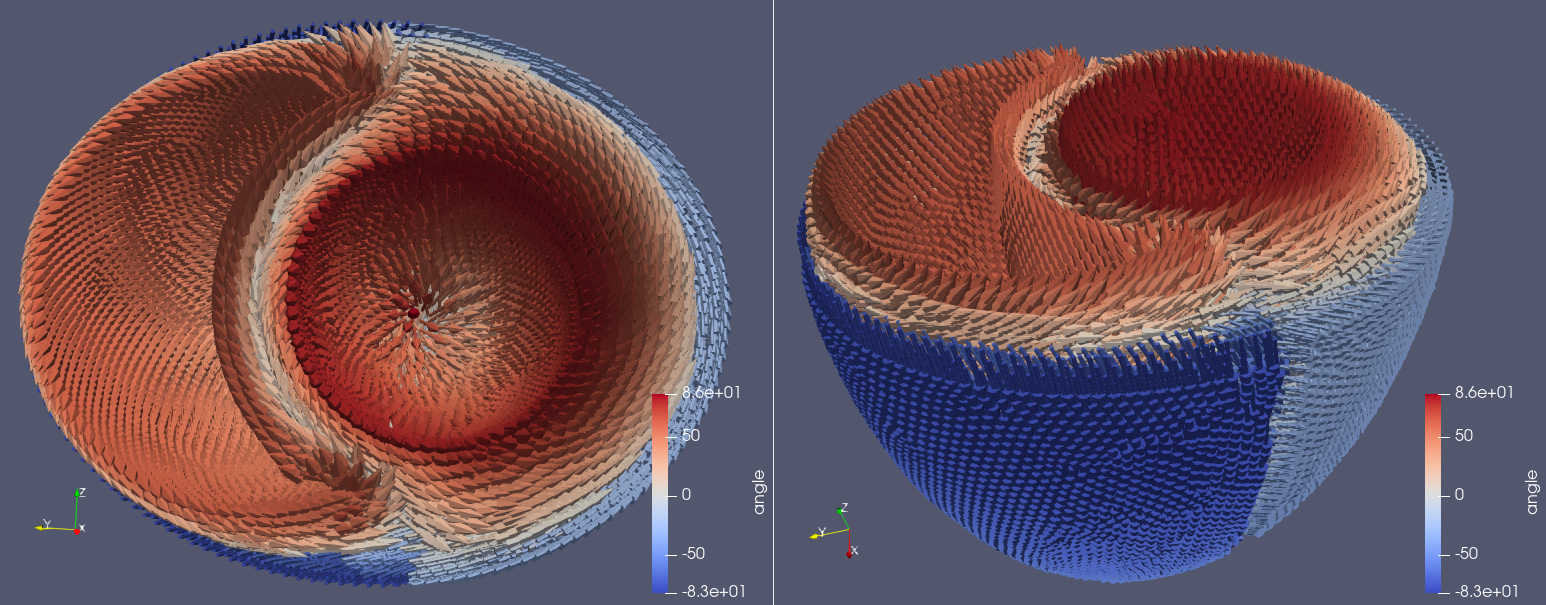Creating fibers on a simple BiV ellipsoid#
In this demo we will create fibers from the simple idealized BiV ellipsoid. We will use a library called cardiac-geometries to generate the mesh.
This library can be installed with pip, i.e pip install cardiac-geometries, but note that it also requires gmsh with OpenCASCADE to be installed.
import dolfin as df
import ldrb
import cardiac_geometries
Here we just create a lv mesh using `cardiac-geometries``
geometry = cardiac_geometries.create_biv_ellipsoid(char_length=0.2)
The mesh is stored as an attribute mesh
mesh = geometry.mesh
The facet function (function with marking for the boundaries) is stored as an attribute ffun
ffun = geometry.ffun
A dictionary with keys and values for the markers as stored in the attribute markers. These markers are loaded from the underlying gmsh files, and has to be slightly modified to work with ldrb as ldrb expected a dictionary with the keys being "base", "epi", "lv" and "rv".
markers = geometry.markers
markers = {
"base": geometry.markers["BASE"][0],
"epi": geometry.markers["EPI"][0],
"lv": geometry.markers["ENDO_LV"][0],
"rv": geometry.markers["ENDO_RV"][0],
}
Also if you want to to this demo in parallel you should create the mesh in serial and save it to e.g xdmf
with df.XDMFFile(mesh.mpi_comm(), "mesh.xdmf") as xdmf:
xdmf.write(mesh)
And when you run the code in parallel you should load the mesh from the file.
mesh = df.Mesh()
with df.XDMFFile("mesh.xdmf") as xdmf:
xdmf.read(mesh)
You should also save the facet function
with df.XDMFFile(mesh.mpi_comm(), "ffun.xdmf") as xdmf:
xdmf.write(ffun)
and read it agin
ffun = df.MeshFunction("size_t", mesh, 2)
with df.XDMFFile("ffun.xdmf") as xdmf:
xdmf.read(ffun)
Choose space for the fiber fields This is a string on the form {family}_{degree}
fiber_space = "Lagrange_2"
Compute the microstructure
fiber, sheet, sheet_normal = ldrb.dolfin_ldrb(
mesh=mesh,
fiber_space=fiber_space,
ffun=ffun,
markers=markers,
alpha_endo_lv=80, # Fiber angle on the LV endocardium
alpha_epi_lv=-30, # Fiber angle on the LV epicardium
beta_endo_lv=0, # Sheet angle on the LV endocardium
beta_epi_lv=0, # Sheet angle on the LV epicardium
alpha_endo_sept=80, # Fiber angle on the Septum endocardium
alpha_epi_sept=-60, # Fiber angle on the Septum epicardium
beta_endo_sept=0, # Sheet angle on the Septum endocardium
beta_epi_sept=0, # Sheet angle on the Septum epicardium
alpha_endo_rv=60, # Fiber angle on the RV endocardium
alpha_epi_rv=-80, # Fiber angle on the RV epicardium
beta_endo_rv=0, # Sheet angle on the RV endocardium
beta_epi_rv=0,
)
Store the results
with df.HDF5File(mesh.mpi_comm(), "biv.h5", "w") as h5file:
h5file.write(fiber, "/fiber")
h5file.write(sheet, "/sheet")
h5file.write(sheet_normal, "/sheet_normal")
If you run in parallel you should skip the visualization step and do that in serial in stead. In that case you can read the the functions from the xml Using the following code
V = ldrb.space_from_string(fiber_space, mesh, dim=3)
fiber = df.Function(V)
sheet = df.Function(V)
sheet_normal = df.Function(V)
with df.HDF5File(mesh.mpi_comm(), "biv.h5", "r") as h5file:
h5file.read(fiber, "/fiber")
h5file.read(sheet, "/sheet")
h5file.read(sheet_normal, "/sheet_normal")
You can also store files in XDMF which will also compute the fiber angle as scalars on the glyph to be visualised in Paraview. Note that these functions don’t work (yet) using mpirun
# (These function are not tested in parallel)
ldrb.fiber_to_xdmf(fiber, "biv_fiber")
# ldrb.fiber_to_xdmf(sheet, "biv_sheet")
# ldrb.fiber_to_xdmf(sheet_normal, "biv_sheet_normal")

